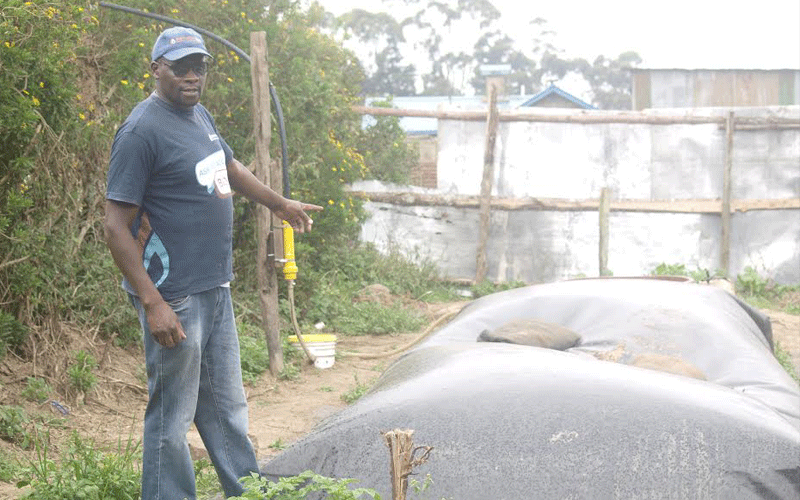Farmer turns cow dung into clean fuel, fertiliser
By Joseph Maina, December 1, 2020Patrick Kimani is leading fellow farmers in Nyandarua county in adoption of a simple technology that derives biogas from cowdung to power their farm machinery, heat up their homes, cook and produce fertiliser for their crops
Patrick Kimani Mbugua speaks with unrestrained passion about biogas as a game changer in the agricultural and energy sector.
He terms the organic waste based biofuel as a largely untapped, environmentally friendly resource that could cater to majority of domestic needs, and provide much-needed relief to forests and the general environment.
To add to this, biogas provides another lesser-known advantage; that of protecting firewood users, from the ravages of smoky kitchens by improving their respiratory health.
“We teach farmers that one doesn’t need to cut a tree in order to cook, and they also get to save themselves from long term health effects of using firewood to cook and paraffin as a source of light,” Kimani told Agribiz at his farm in Magumu, Nyandarua county.
Working under a social enterprse firm Sistema Bio, an organisation that operates under the mantra of creating value from waste as a sales manager, they create a bio-digester package that produces biogas for thermal and mechanical energy and biofertiliser.
“We discourage the use of chemical fertiliser, pesticides and other synthetic inputs.
The crops grow crammed with all manner of chemicals becoming a health hazard.
Ideally, we encourage the people to feed the farms, as opposed to feeding the plants,” says Kimani who educates farmers organised in community groups and cooperatives.
His overall philosophy is that of careful use of the environment so as to reap maximum benefits, with the least possible damage to the user.
He says there is less value to the environment and greater risk to health when people cut trees.
It’s against this background that Kimani’s organisation prescribes the use of biogas as an environmentally friendly alternative to domestic energy needs of a household.
Sistema Bio is a hermetic hybrid reactor that receives daily farmyard waste, in which the manure mixed with water is fermented to produce biogas that is conducted through pipes to the points of use. At the end of the system comes a bio-fertiliser.
How it works
Kimani’s farm is an arena of perennial verdure. On one side of his farm is a healthy crop of spinach, neighbouring another plot of succulent kales.
All this, he says, is courtesy of his use of organic manure that he draws from his biogas structure.
“Originally, this was poor soil,” he beams as we admire the lushness of his crops.
“It had a greyish colour, was deficient in the necessary plant nutrition and could hardly sustain crops.
But what you see now is the result of the biofertiliser. Not a pellet of commercial fertiliser has been applied to this farm for years.,” he adds.
From the biodigester, gas moves to the house via a system of pipes, all suspended from the ground. This, he says, helps with troubleshooting.
Saves money
His family uses the gas for cooking and heating the house. It costs Sh150,000 to install the biogas system.
“Biogas is a worthwhile investment for the typical rural household, at least in the long term,” Kimani told Agribiz adding, “If you calculate the amounts spent to fuel a typical household using charcoal or wood fuel, biogas is a viable and affordable alternative.
Thanks to my investment in biogas, I can now maximise on the family’s cow, as the waste from the animal serves multiple purposes. With the biogas system you get fuel and organic fertiliser.”
A key product of the biogas system is methane gas, which is normally used for cooking and heating in a domestic setting.
The gas is burnt in a special stove that is made specifically for biogas, and differs in design from your typical Liquefied Petroleum Gas (LPG) burner.
Biogas is less flammable than LPG gas, and as Kimani demonstrated, it doesn’t easily catch flame.
In addition to fuel and fertiliser, the biogas system produces a healthy meal for chicken.
“Chicken, particularly kienyeji (indigenous) chicken, have a tendency of generating fat in their bodies.
To prevent this, we mix the usual chicken feed with effluent from the biodigester, at a ratio of four to one respectively.
This enriches the feed with nitrogen, which helps chicken to convert their fat into flesh, resulting in meatier animals with less body fat,” he offers.
